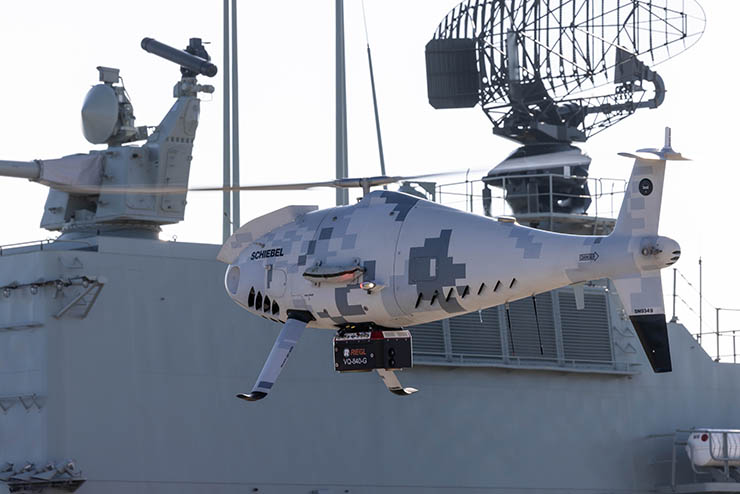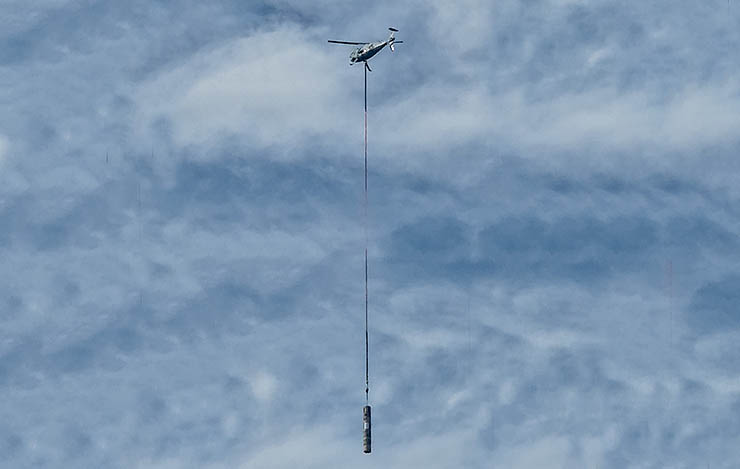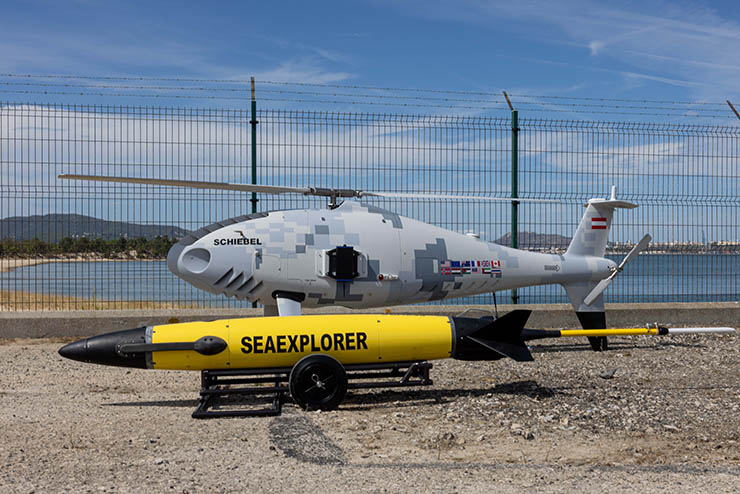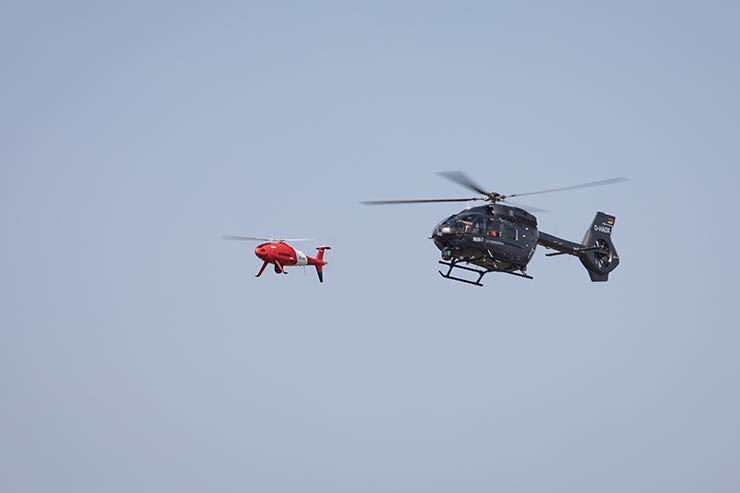The rapid evolution of technology in the maritime sector has compelled major navies worldwide to embrace emerging and disruptive technologies more frequently. Recent advancements in naval combat systems have significantly impacted various key capabilities, including unmanned systems. The escalating global conflicts have intensified geopolitical rivalries, extending them to the world’s oceans. Major global powers are increasingly investing in enhancing their naval capabilities to effectively engage adversaries and disrupt their infrastructure across extended ranges. The focus is on modernisation, transitioning to a force that integrates unmanned and manned ships, aircraft, and underwater vehicles, leveraging technological advancements to be well-prepared for high-end naval warfare and power projection.
The globally operating Schiebel Group specialises in the development, design, and production of the revolutionary CAMCOPTER® S-100 Unmanned Air System (UAS). Certified to meet AS/EN 9100 standards, Schiebel has earned an international reputation for delivering high-tech military, commercial, and humanitarian products, supported by exceptional after-sales service. Aligned with India’s Aatmanirbharta goal, Schiebel has become a key player in the Indian defence ecosystem, establishing a robust supply chain to achieve around 60% indigenous components in its flagship CAMCOPTER® S-100 UAS. The Vertical Take-off and Landing (VTOL) UAS requires no prepared area or supporting equipment for launch and recovery, operating day and night, under adverse weather conditions, with a beyond line-of-sight capability of up to 200 km / 108 nm over land and sea. Its carbon fibre and titanium fuselage provide the capacity for a wide range of payload/endurance combinations, up to a service ceiling of 5,500 m / 18,000 ft.
Schiebel has earned an international reputation for delivering high-tech military, commercial, and humanitarian products, supported by exceptional after-sales service. Aligned with India’s Aatmanirbharta goal, Schiebel has become a key player in the Indian defence ecosystem, establishing a robust supply chain to achieve around 60% indigenous components in its flagship CAMCOPTER® S-100 UAS
Preparing for Future Warfare
Recognising the intricacies of fifth-generation warfare, the Indian Navy has embraced technological advancements, positioning itself as a smart navy with a diverse range of capabilities. Despite numerous challenges, the Indian Navy remains focused on niche disruptive and emerging technologies, seeking optimal solutions for current and future threats. India’s emergence as a global power has elevated the role of the Indian Navy, effectively projecting India’s power with its extensive maritime outreach. Aiming to become an Aatmanirbhar Naval Force by 2047, the Indian Navy leads India’s self-reliance drive, actively seeking future technologies to gain an edge in the sea-based battlefield.

Schiebel has consistently been ahead of the curve in the tactical rotary UAS domain, continually updating its arsenal with newer sensors and operational concepts. Demonstrating its maritime capabilities, the CAMCOPTER® S-100 has excelled in NATO exercises REPMUS (Robotic Experimentation and Prototyping using Maritime Uncrewed Systems) and Dynamic Messenger 2023. Collaborating with various partners, Schiebel has showcased the CAMCOPTER® S-100 in Anti-Submarine Warfare (ASW) sonobuoy deployment, bathymetric scanning for Rapid Environmental Assessment (REA), Mine Counter Measures (MCM), and Autonomous Underwater Vehicle (AUV) and profiling float deployment.
Revolutionising ASW
Building on last year’s REPMUS, where Schiebel, in collaboration with Thales, demonstrated data relay from sonobuoys, and this year’s achievement of successfully dispensing NATO standard G-size sonobuoys, Schiebel has introduced a new dimension to ASW, making it more dynamic and flexible in deployment, leading to more effective engagement by both surface and sub-surface combatants. Combining these capabilities enables Schiebel to provide an end-to-end solution for ASW. The S-100 can carry up to four sonobuoys and automatically deploy them with its newly developed sonobuoy dispenser. Once in position, the S-100 is equipped with Thales’ BlueScan® acoustics system, relaying real-time underwater acoustic multi-sensor data to a Combat Management System (CMS) on a ship.

Autonomous Wingman / Manned-Unmanned Teaming
The evolution of unmanned aerial systems, coupled with advancements in autonomous operations driven by Artificial Intelligence (AI) and the establishment of secure data-links, has paved the way for a groundbreaking concept – Manned-Unmanned Teaming (MUM-T). This innovative approach combines the strengths of manned and unmanned aerial platforms, delivering exceptional accuracy, operational flexibility, and continuous machine learning. Integrating unmanned autonomous systems into mission planning broadens the spectrum of accessible mission parameters without exposing costly manned aircraft and their crews to high-threat environments.
These unmanned wingmen can perform a range of critical missions, from Intelligence, Surveillance, and Reconnaissance (ISR) to tactical early warning tasks and Suppression of Enemy Air Defences (SEAD). Their cost-effective design empowers operators to deploy them at the forefront of operations. Ranging from small fighters to substantial platforms with fighter-like performance, long-range capabilities, and extended endurance, these unmanned platforms, equipped with integrated sensor packages, are versatile enough to support various missions, with some even capable of carrying weapons. Their formation flexibility and coordinated manoeuvres further enhance their adaptability.
Breakthrough in MCM
In the field of MCM, the CAMCOPTER® S-100 successfully demonstrated the VQ-840-G LiDAR from the Austrian company RIEGL, working in conjunction with Thales. Utilising the open architecture of the Thales MCM Mission Management System (M-CUBE), enabling rapid and flexible third-party sensor integration, the CAMCOPTER® S-100 performed complete airborne MCM mine detection, achieving 100% detection of all mine targets. This capability is a significant boost for navies operating in potential mine-proliferated waters, requiring effective mine avoidance or hunting measures.

Advancing REA
Schiebel showcased its role in supporting advanced Rapid Environmental Assessment (REA) missions, deploying the Yuco AUV from the French company Seaber and the APEX profiling float from Teledyne, using the proven cargo hook on the S-100. The Fugro Rapid Airborne Multibeam Mapping System (RAMMS) from the US Company Areté contributed to the topobathymetric product, closing the surf zone gap safely inaccessible by surface assets. This capability provides bathy assessment to the vessel before arrival, aiding tactical avoidance of underwater threats and engagement of threats for Anti-Submarine Frigates.

Unmanned-Unmanned Teaming
The Unmanned-Unmanned Teaming (U-UT) concept was presented at the NATO exercise, with the S-100 relaying data from ALSEAMAR’s SEAEXPLORER glider to a Combat Management System (CMS), validating the underwater vehicle’s capability to operate in a satellite-denied environment. This marks the future of autonomous underwater systems operating in tandem with rotary UAS for hovering and flying options. Demonstrating this capability during REPMUS opens avenues for navies to explore these options in real-time scenarios, ensuring high probability of data collation and analysis.

Unmanned Future Beckons
Unmanned solutions for ASW, MCM, REA, and Maritime Security Operations (MSO) are increasingly relevant in today’s naval defence. During the month-long large-scale NATO exercise, Schiebel showcased its multi-mission capability by reconfiguring the CAMCOPTER® S-100 between missions, conducting various operations.
“Being NATO exercises, REPMUS and Dynamic Messenger are exceptional playgrounds to demonstrate our innovative capabilities. The S-100 once again proved to be a vital unmanned asset in supporting the latest maritime defence solutions, such as ASW and MCM – offering highly sought-after capabilities,” said Hans Georg Schiebel, Chairman of the Schiebel Group.
With a long-term vision, Schiebel is confident in harnessing immense business opportunities in the Indian defence and civilian market, positioning itself as a market leader with its innovative and mission-proven product offerings. Having made the right moves in time, Schiebel sets its sights on a forward collaborative journey with its Indian partners.
Raksha Anirveda's editorial desk team brings in the collective experience of creative professionals - a fine mix of senior copy editors, writers, proofreaders and designers. Working as a team, they continuously create, manage, and curate content to sustain the magazine's profile and reputation in line with market trends and achieve magazine's goal.






